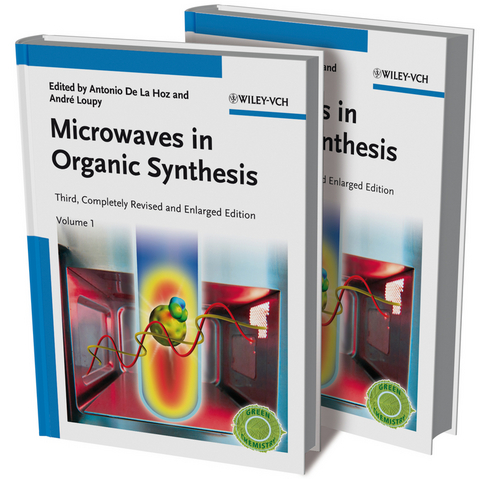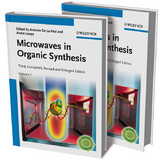Microwaves in Organic Synthesis
Wiley-VCH (Verlag)
978-3-527-33116-1 (ISBN)
- Titel ist leider vergriffen;
keine Neuauflage - Artikel merken
The third edition of the bestselling two-volume reference covers everything you need to know about microwave technology for synthesis- from the best equipment to nonthermal effects, from solid-support reactions to catalysis. Completely revised and updated with half of the authors completely new to the project, this comprehensive work is clearly divided into two parts on the fundamentals of microwave irradiation, and application of microwaves and synergies with other enabling techniques. Also new to this edition are chapters on on-line monitoring, flow chemistry, combination with ultrasounds and natural products, including multicomponent reactions.An indispensable source for organic, catalytic, physical, and medicinal chemists.
André Loupy received his PhD in 1975 from Paris-South University under the direction of Dr. Jacqueline Seyden-Penne in the Centre National de la Recherche Scientifi que (CNRS) in Thiais. He joined the Laboratory of Selective Reactions in Centre of Orsay from Paris-South University (director : Pr. Georges Bram). He became the first class director of research at CNRS, where he led this lab until the end of 2005 when he retired. He was co-author of roughly 300 publications and 10 chapters in several books. Together with Pr. Georges Bram, Dr. Loupy was concerned with microwave activation since 1987, especially when coupled with safe and economical solvent-free conditions ('green chemistry') and the non-alimentary valorization of products from agriculture. His most recent research was focused on medium effects in organic synthesis including solvent and salt effects, solvent-free conditions with a special interest in supported reactions and phase transfer catalysis and activation by microwaves. Antonio de la Hoz is Professor in Organic Chemistry in the University of Castilla-La Mancha. He obtained his PhD from the Universidad Complutense in Madrid in 1986 under the supervision of Prof. José Elguero and Carmen Pardo. After postdoctoral research in 1987 with Prof. Mikael Begtrup at the Danmarks Tekniske Høskole, Denmark, he joined the Faculty of Chemistry of the Universidad de Castilla-La Mancha in Ciudad Real in 1988 as an Assistant Professor. In 1993 he worked under the supervision Prof. André Loupy in the Université de Paris-Sud in Microwave Assisted Organic Chemistry. Prof. de la Hoz has authored over 170 scientific publications - 100 of them related to Microwaves in Organic Synthesis. Dr. de la Hoz is a founding member of the Spanish Green Chemistry Network. His current research interests focus on Green methodologies, microwave activation, mechanochemistry, flow methodologies and solvent-free reactions, and the applications of heterocyclic compounds in material and supramolecular chemistry.
Contents to Volume 1
PREFACE
PART I: Fundamental Aspects of Microwave Irradiation in Organic Chemistry
MICROWAVE - MATERIALS INTERACTIONS AND DIELECTRIC PROPERTIES: FROM MOLECULES AND MACROMOLECULES TO SOLIDS AND COLLOIDAL SUSPENSIONS
Fundamentals of Microwave - Matter Interactions
Dielectric Properties and Molecular Behavior
Conclusion
DEVELOPMENT AND DESIGN OF REACTORS IN MICROWAVE-ASSISTED CHEMISTRY
Introduction
Basic Concepts for Reactions and Reactors in Organic Synthesis
Methods for Enhancing the Rates of Organic Reactions
Microwave-Assisted Organic Syntheses
Commercial Microwave Reactors
Selected Equipment and Applications
Qualification and Validation of Reactors and Results
Conclusion and the Future
KEY INGREDIENTS FOR MASTERY OF CHEMICAL MICROWAVE PROCESSES
The Systemic Approach
Thermal Dependence of Dielectric Loss
Electric Field Effects
Loop Modes or Strange Solutions of Maxwell's Equations
Hydrodynamic Aspects
Thermodynamic and Other Effects of Electric Fields
Athermal and Specific Effects of Electric Field
The Thermal Path Effect: Anisothermal Conditions
Hot Spots and Heterogeneous Kinetics
Conclusion
NONTHERMAL EFFECTS OF MICROWAVES IN ORGANIC SYNTHESIS
Introduction
Origin of Microwave Effects
Specific Nonthermal Microwave Effects
Effects of the Medium
Effects Depending on Reaction Mechanisms
Effects Depending on the Position of the Transition State Along the Reaction coordinate
Effects on Selectivity
Some Illustrative Examples
Concerning the Absence of Microwave Effects
Conclusion: Suitable Conditions for Observation of Specific MW Effects
SELECTIVITY MODIFICATIONS UNDER MICROWAVE IRRADIATION
Introduction
Selective Heating
Modification of Chemoselectivity and Regioselectivity
Modification of Stereo- and Enantioselectivity
Conclusion
ELUCIDATION OF MICROWAVE EFFECTS: METHODS, THEORIES, AND PREDICTIVE MODELS
Introduction
Thermal Effects
Non-Thermal Effects
Conclusion
MICROWAVE SUSCEPTORS
Introduction
Graphite as a Sensitizer
Graphite as Sensitizer and Catalyst
The Use of Silicon Carbide Susceptors in Microwave Chemistry
TOOLS FOR MONITORING REACTIONS PERFORMED USING MICROWAVE HEATING
Introduction
Watching Microwave-Heated Reactions in Real Time
Monitoring Microwave-Heated Reactions Using InSitu Spectroscopic Tools
Conclusion
MICROWAVE FREQUENCY EFFECTS IN ORGANIC SYNTHESIS
Introduction
Historical Review of Microwave Frequency Effects in Chemical Reactions
Microwave Chemical Reaction Apparatus Operating at Various Frequencies
Frequency Effects and Heating Efficiency in Various Solutions
Examples of Chemical Reactions Impacted by Microwave Frequency Effects
Conclusion
PART II: Applications of Microwave Irradiation
ORGANIC SYNTHESIS USING MICROWAVES AND SUPPORTED REAGENTS
Introduction
Microwave-Accelerated Solvent-Free Organic Reactions
Protection - Deprotection Reactions
Condensation Reactions
Isomerization and Rearrangement Reactions
Diels - Alder Cycloaddition of a Triazole Ring
Addition Reactions
Oxidation Reactions - Oxidation of Alcohols and Sulfides
Reduction Reactions
Synthesis of Heterocyclic Compounds
Miscellaneous Reactions
Conclusion
GASEOUS REACTANTS IN MICROWAVE-ASSISTED SYNTHESIS
Introduction
Liquid-Phase Synthesis
Wet Air Oxidation
Gas-Phase Synthesis
Waste Gas Treatment
Conclusion and Outlook
MICROWAVES AND ELECTROCHEMISTRY
Introduction to Microwave Assisted Electrode Processes
Macroelectrode Processes in the Presence of Microwaves
Microelectrode Processes in the Presence of Microwaves
Junction-Electrode Processes in the Presence of Microwaves
Electrochemical Flow Reactor Processes in the Presence of Microwaves
Future Trends
THE COMBINED USE OF MICROWAVES AND ULTRASOUND: METHODS AND PRACTICE
Introduction
The Search for the Best Coupling
Microwave- and Ultrasound-Enhanced Synthesis and Catalysis
Formation of Advanced Materials
Conclusion and Future Trends
MICROWAVES IN PHOTOCHEMISTRY AND PHOTOCATALYSIS
Introduction
UV/Vis Discharges in Electrodeless Lamps
Microwave Photochemical and Photocatalytic Reactors
Interactions of UV/Vis and Microwave Radiation with Matter
Microwave Photochemistry and Photocatalysis
Applications
Future Trends
Contents to Volume 2
PREFACE
MICROWAVE-HEATED TRANSITION METAL-CATALYZED COUPLING REACTIONS
Introduction
Cross-Coupling Reactions
Arylation of C, N, O, S, P and Halogen Nucleophiles
The Heck Reaction
Carbonylative Coupling Reactions
Conclusion
MICROWAVES IN HETEROCYCLIC CHEMISTRY
Introduction
Microwave-Assisted Synthesis of Four- and Five-Membered Systems with One and More Than Two Heteroatoms
Six-Membered Systems with One Heteroatom
Six-Membered Systems with More Than One Heteroatom
Bicyclic Systems (Six Atoms + Five Atoms) with One, Two, and More Heteroatoms
Bicyclic Systems (Six Atoms + Six Atoms) with One, Two, and More Heteroatoms
Seven Membered Heterocycles with Two Heteroatoms: Microwave-Assisted Synthesis of Benzodiazepines and Related Compounds
Microwave-Assisted Nucleophilic Aromatic Substitution (SNAr)
Microwaves in Total Synthesis of Bioactive Heterocycles
Conclusion
MICROWAVE-ASSISTED CYCLOADDITION REACTIONS
Introduction
Microwave-Assisted [3 + 2]-Cycloaddition Reactions
Microwave-Assisted [4 + 2]-Cycloaddition Reactions
Microwave-Assisted [2 + 2]-Cycloaddition Reactions
Other Microwave-Assisted Cycloaddition Reactions
Conclusion
MICROWAVE-ASSISTED HETEROGENEOUSLY CATALYZED PROCESSES
Introduction
Acid-Catalyzed Reactions
Based-Catalyzed Reactions
Redox Reactions
Coupling Reactions
Other Reactions
Conclusion and Outlook
MICROWAVES IN THE SYNTHESIS OF NATURAL PRODUCTS
Introduction
Total Synthesis of Various Classes of Natural Products
Total Synthesis of Various Classes of Alkaloids
Synthesis of Analogs of Natural Products
Synthesis of Building Blocks (Subunits) for Natural Product
Conclusion and Overview
MICROWAVE-ENHANCED SYNTHESIS OF PEPTIDES, PROTEINS, AND PEPTIDOMIMETICS
Introduction
Synthesis Approaches
Microwave Theory for Peptide Synthesis
Na-Amino Protection Strategies
Amide Bond Formation
Modified Peptides
Non-Natural Peptidomimetics
Resin Cleavage
Recommended Protocols
Conclusion
Abbreviations
A JOURNEY INTO RECENT MICROWAVE-ASSISTED CARBOHYDRATE CHEMISTRY
Introduction
Acylation
Glycosylation
Halogenation-Dehalogenation
Sulfation
Anomerization
Synthesis of Sugar Derivatives
Synthesis of Biologically and Pharmacological Active Compounds
Synthesis of Heterocycles
Synthesis of Phosphorus Compounds
Synthesis of Nanostructured Materials
Conclusion
POLYMER CHEMISTRY UNDER MICROWAVE IRRADIATION
Introduction
Synthesis of Polymers Under Microwave Irradiation
Conclusion
APPLICATION OF MICROWAVE IRRADIATION IN CARBON NANOSTRUCTURES
Fullerenes Under Microwave Irradiation
Microwave Irradiation in Carbon Nanotubes
Microwave Irradiation in Other Carbon Nanoforms
Conclusion
MICROWAVE-ASSISTED MULTICOMPONENT REACTIONS IN THE SYNTHESIS OF HETEROCYCLES
Introduction
Nitrogen Heterocycles
Oxygen-Containing Rings
Sulfur-Containing Rings
Oxygen- and Nitrogen-Containing Rings
Carbacycles
Multiple Ring Systems
Conclusion
Abbreviations
MICROWAVE-ASSISTED CONTINUOUS FLOW ORGANIC SYNTHESIS (MACOS)
Introduction
Equipment
MACOS in Homogeneous System
MACOS in Heterogeneous System
Conclusion and Outlook
INDEX
| Erscheint lt. Verlag | 5.12.2012 |
|---|---|
| Verlagsort | Weinheim |
| Sprache | englisch |
| Maße | 170 x 240 mm |
| Gewicht | 3065 g |
| Themenwelt | Naturwissenschaften ► Chemie ► Organische Chemie |
| Schlagworte | Chemie • Chemistry • Industrial Chemistry • Methods - Synthesis & Techniques • Methods - Synthesis & Techniques • Mikrowellentechnik • Nachhaltige u. Grüne Chemie • Organische Chemie / Methoden, Synthesen, Verfahren • Organische Synthese • Pharmaceutical & Medicinal Chemistry • Pharmaceutical & Medicinal Chemistry • Pharmazeutische u. Medizinische Chemie • Sustainable Chemistry & Green Chemistry • Sustainable Chemistry & Green Chemistry • Technische u. Industrielle Chemie |
| ISBN-10 | 3-527-33116-6 / 3527331166 |
| ISBN-13 | 978-3-527-33116-1 / 9783527331161 |
| Zustand | Neuware |
| Haben Sie eine Frage zum Produkt? |
aus dem Bereich




